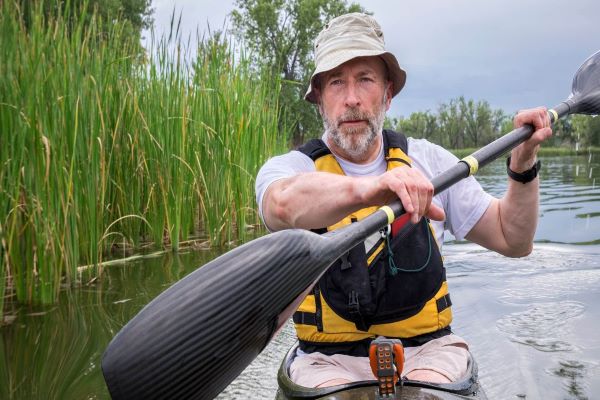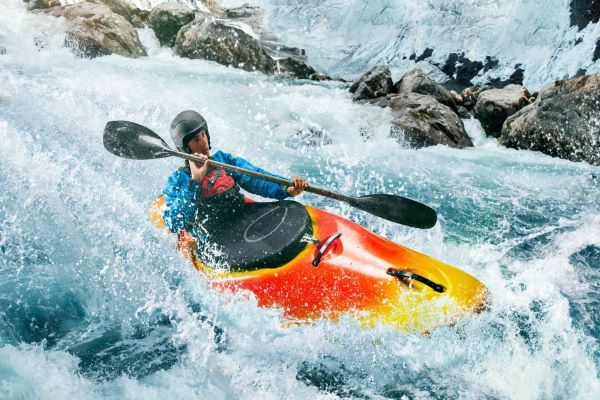When it comes to kayaking, having good control over your boat is key – especially when it comes to edging. Whether you’re a beginner or an expert, learning how to edge your kayak can take your paddling skills to the next level. In this post, we’ll look at what edging is and how you can use it to improve your kayaking technique. We’ll also provide some tips for beginners on how to start edging their kayaks safely and effectively. So, read on for all you need to know about edging a kayak!
What is edging and why is it important for kayakers of all levels?
Edging is a kayaking technique that allows you to control your boat with precision in order to navigate strong currents and manoeuvre through rapids. It can be used at different levels, depending on the situation.
Edging is an essential skill for all kayakers as it gives you more control over your boat in different situations. It can help you catch eddies, boof over waves, peel out from banks, and ferry across currents. Using edging effectively can also help you run rapids with more precision and safety. So, if you want to become a better kayaker, learning how to edge is a skill you don’t want to ignore!
How to edge a kayak at different levels
There are different levels of edging that can be used, depending on the level of whitewater you are paddling.
Here are a few tips on how to edge your kayak on the left side at different levels – you can do the reverse if edging on the right side:
Connect with your boat:

Whether you’re a beginner or an expert, start by learning how to or making sure you maintain a good posture and balance in your boat.
You want to be connected firmly with your boat at the five points – your both feet, thighs and butt; your feet firmly secured on your foot pegs, thigh braces in place, and you have adjusted your seat to a comfortable, balanced position.
Next, try to relax your knees, while your boat is still flat at this point. You can then proceed to level 1 of edge control.
Level 1:
Once you’re in the starting position for level 1, lift your left butt cheek and engage your left knee (by raising it higher than your right knee). You should then be edging at this point.
Level 2:
Level 2 requires you to use a combination of level 1 and level 2 techniques. Lift your left butt cheek higher than before while also engaging your left knee by making it rise higher than your right. Then, lean your torso slightly to the right-hand side. You will be in the advanced position for level 2 once all of these adjustments have been made.
Level 3:
Use the techniques from levels 1 and 2, combined with tilting your rib cage to the right side of the kayak. Lean your torso towards the right while keeping your head in line with center of boat. Engage the left knee by lifting it higher than the right knee. Do not lean so much that you flip over; You should be on edge at this point..
Level 4:
To reach level 4, combine the techniques from levels 1-3 and go as far as you can on your right edge without flipping over. This can be helpful in most extreme whitewater conditions.
Note that when leaning to adjust your balance or support your turn while edging in whitewater, you should try to keep your head over at the center line of your boat.
How can you start edging your kayak safely and effectively as a beginner paddler?
If you’re a beginner kayaker, it’s important to start edging your kayak safely and effectively. Here are a few tips to help you get started:
1. Start by practicing in flat water:
It’s important to start slowly and build your way up to more challenging edging techniques. So, start by practicing in flat water and work your way up to level 1 of edging in whitewater.
2. Use a stable boat:
When you’re starting out, it’s best to use a stable boat that won’t flip over easily. This will help you feel more confident when trying out the edging techniques.
3. Use a lower level of whitewater:
If you are whitewater kayaking, start out edge control on a lower level of whitewater, so that you can focus on mastering the edging techniques without being too challenged.
4. Use an experienced kayaker as a mentor:
If you’re feeling lost or unsure about how to edge your kayak safely and effectively, find an experienced kayaker to mentor you and help guide you along the way.
With these tips in mind, you should be well on your way to starting safe and effective edging as a beginner paddler!
How can surfing, boofing, and ferrying current be improved with proper edging technique?
Surfing, boofing, and ferrying are key components of whitewater kayaking. With the proper edging technique, you can improve your ability to do these activities safely and effectively.
Surfing + edging:

To surf a river wave in your kayak, edge your kayak just like you would an ocean surfboard. If you want to go right, use the right edge of your kayak. For left, use the left side. Keep alternating sides and using rudder strokes; before long, you’ll be surfing in your kayak!
Eddy line + Boofing + edging:

Boofing is a great way to get down a rapid without flipping over. When boofing off an eddy line, it’s important to use proper edging technique. Ensure you have enough cross-current speed and control as you approach the drop.
Lift your upstream edge while reaching with a prolonged downstream vertical paddle stroke – edge on the side of the boat that is opposite to where you want to go for better control. Timing is important here, and maintaining the edge during the drop can help you land effectively. Use your hip to flatten the boat for a better landing.
Ferrying current + edging:

Ferrying across the current is a great way to get from one side of the river to another. This can be done by setting your boat angle at 45 degrees and maintaining it throughout your crossing. To counteract the effect of the current from pushing your bow downstream, you’ll want to use stern draws on your downstream side and maintain a consistent boat angle with each stroke. A lot of speed isn’t necessary, but maintain your downstream stroke for the entirety of your ferrying journey.
Remember to keep the upstream edge of your boat up so that you don’t flip over. It’s also important to focus on where you want to travel – vision is important when it comes to successful ferrying! Once you’ve set your edge and angle as you’re making your move into the current, make sure to look at where you want to go.
The benefits of mastering edging control
Most kayakers would agree that mastering edging control is key to becoming a successful whitewater kayaker. With the proper edging technique, you can improve your skills in a number of areas – from surfing river waves to boofing off of eddy lines.
In addition, here are some other benefits of mastering edging control:
1) Increased speed and efficiency:
When you’re able to properly edge your kayak, you’ll move more quickly and efficiently through the water. This is because you’ll be using less energy to navigate your way downstream.
2) Improved boat control:
With better boat control, you’ll have more confidence when tackling more challenging rapids and whitewater features. This means you’ll be able to execute moves with greater precision and ease.
3) Greater stability:
Edging your kayak also helps to improve its stability, which is especially important when paddling in turbulent water conditions. When your kayak is stable, you’ll feel more confident and safe as you paddle.
So, as you can see, there are a number of benefits to mastering edging control! With a little practice and patience, you too can become an expert edger and take your kayaking skills to the next level.
Final tips on how to become an expert edger and take your kayaking skills to the next level!
Becoming an expert edger is all about practice and patience. Here are a few final tips to help you master this essential kayaking skill:
1) Start off slowly:
When you’re first starting out, it’s important to take things slowly. Don’t try to tackle too many difficult rapids or whitewater features at once. Instead, focus on practicing your edging techniques in a safe and controlled environment.
2) Use a variety of terrain:
In order to become an expert edger, it’s important to use a variety of terrain. This will help you to develop a well-rounded skillset and increase your overall proficiency when it comes to edging.
3) Stay focused:
One of the most important things when it comes to becoming an expert edger is focus. Make sure you’re aware of your surroundings at all times and that you have a clear vision of where you want to go. This will help you stay safe as you paddle and improve your kayaking skills even further.
4) Take a kayaking course:
Finally, taking a kayaking course is one of the best ways to become an expert edger. Kayaking courses are designed to help you develop your skills in a safe and structured environment and can provide you with invaluable insights into proper technique.
By following these tips, you can become an expert edger and take your kayaking skills to the next level in no time. So, get out there and start practicing your edging techniques. Good luck!
Leave a comment below to let us know how your edging skills are progressing! 🙂
